Discover Florida Nature
It's time to explore the natural Florida


|
|
|
|
|
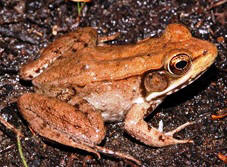 Bronze
Frog- The Bronze Frog got his name because of the distinctly
bronze coloration on its upper surfaces. This is a handsome frog, but
seldom seen, since it is mainly nocturnal. During the day the Bronze
frog hides under rotting logs or other debris, usually close to water,
but is easily spooked from its hiding place. Bronze frogs see habitats
with flowing water, such as small creeks and streams. The Bronze Frog
breeds during the warmer months of the year. This frog's call is a
strange single note that sounds very much like a plucked banjo string.
Sometimes the note will be repeated several times. Bronze
Frog- The Bronze Frog got his name because of the distinctly
bronze coloration on its upper surfaces. This is a handsome frog, but
seldom seen, since it is mainly nocturnal. During the day the Bronze
frog hides under rotting logs or other debris, usually close to water,
but is easily spooked from its hiding place. Bronze frogs see habitats
with flowing water, such as small creeks and streams. The Bronze Frog
breeds during the warmer months of the year. This frog's call is a
strange single note that sounds very much like a plucked banjo string.
Sometimes the note will be repeated several times.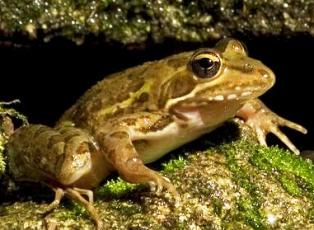 River
Frog- As its name implies, the River Frog is found on the banks
of freshwater rivers and along the edges of river connected creeks and
ponds. The upper surface of the river frog is dark green or brown,
sometimes almost black, and its skin is rough. This frogs underside is
mottled mouse-gray and white. The eyes of the tadpoles are usually
reddish. Unlike other frogs, the river frog does not jump and wiggle
when captured, instead it reacts by becoming limp. If you lay a River
Frog down on its back, it will stay there for a while until you go away.
This frog has an added protection from a foul smelling and toxic
secretion from its skin. Snakes that have been seen eating this frog
become violently ill afterward! The River Frogs call is a brief grunt
or low-pitched snore. River
Frog- As its name implies, the River Frog is found on the banks
of freshwater rivers and along the edges of river connected creeks and
ponds. The upper surface of the river frog is dark green or brown,
sometimes almost black, and its skin is rough. This frogs underside is
mottled mouse-gray and white. The eyes of the tadpoles are usually
reddish. Unlike other frogs, the river frog does not jump and wiggle
when captured, instead it reacts by becoming limp. If you lay a River
Frog down on its back, it will stay there for a while until you go away.
This frog has an added protection from a foul smelling and toxic
secretion from its skin. Snakes that have been seen eating this frog
become violently ill afterward! The River Frogs call is a brief grunt
or low-pitched snore.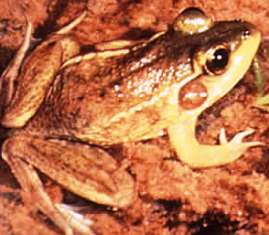 Florida
Bog Frog- On the night of July 22, 1982, Paul Moler, a senior
biologist for the Florida Game and fresh Water Commission listened to a
choir of familiar frog calls when he heard an unfamiliar sounding frog.
He discovered a new species of Rana, the Florida Bog Frog. The
Bog Frog's call as been described as a series of 3 to 21 distinctly un
melodious chucks. The Florida Bog Frog is similar in looks to the
Bronze Frog, except that it is smaller and has greatly reduced webbing
on its hind feet. Less than two inches long, Bog Frogs have rough dark
green to brown backs, black mottled undersides, yellow throats, and may
have light spots on the lower jaw. A light brown line runs along the
lateral fold and does not reach the groin area. Aside from being the
smallest of the "true Frogs", the Florida Bog Frog is also the rarest
species of toads or frogs in the state of Florida, found only in a few
acidic streams in Walton, Santa Rosa, and Okaloosa counties in the
panhandle. Florida
Bog Frog- On the night of July 22, 1982, Paul Moler, a senior
biologist for the Florida Game and fresh Water Commission listened to a
choir of familiar frog calls when he heard an unfamiliar sounding frog.
He discovered a new species of Rana, the Florida Bog Frog. The
Bog Frog's call as been described as a series of 3 to 21 distinctly un
melodious chucks. The Florida Bog Frog is similar in looks to the
Bronze Frog, except that it is smaller and has greatly reduced webbing
on its hind feet. Less than two inches long, Bog Frogs have rough dark
green to brown backs, black mottled undersides, yellow throats, and may
have light spots on the lower jaw. A light brown line runs along the
lateral fold and does not reach the groin area. Aside from being the
smallest of the "true Frogs", the Florida Bog Frog is also the rarest
species of toads or frogs in the state of Florida, found only in a few
acidic streams in Walton, Santa Rosa, and Okaloosa counties in the
panhandle.
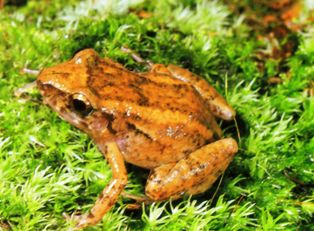 Greenhouse
Frog- The small Greenhouse Frog belongs to a very large family
of tropical frogs found in Central and South America, and the West
Indies. Greenhouse Frogs were introduced into Florida many years ago and
is now quite common in the state. Greenhouse Frogs are a brownish color
and have a somewhat pointed nose. This frog is commonly found around
homes, gardens, and greenhouses, as well as moist wooded areas. The
Greenhouse frog is unique among Florida toads and frogs because it does
not pass through a free-swimming tadpole stage. The female lays her
eggs, not in water, but inside damp rotting logs or under moist debris.
Fully developed miniature froglets hatch directly from the eggs! The
call of the Greenhouse Frog is a soft, pleasant chirping that sounds
something like a cricket. It is frequently heard around houses, often
lawns and shrubs are being watered. Greenhouse
Frog- The small Greenhouse Frog belongs to a very large family
of tropical frogs found in Central and South America, and the West
Indies. Greenhouse Frogs were introduced into Florida many years ago and
is now quite common in the state. Greenhouse Frogs are a brownish color
and have a somewhat pointed nose. This frog is commonly found around
homes, gardens, and greenhouses, as well as moist wooded areas. The
Greenhouse frog is unique among Florida toads and frogs because it does
not pass through a free-swimming tadpole stage. The female lays her
eggs, not in water, but inside damp rotting logs or under moist debris.
Fully developed miniature froglets hatch directly from the eggs! The
call of the Greenhouse Frog is a soft, pleasant chirping that sounds
something like a cricket. It is frequently heard around houses, often
lawns and shrubs are being watered.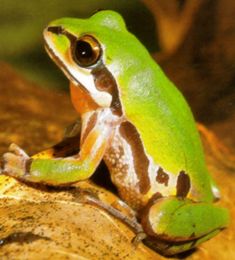 Ornate
Chorus Frog- The Ornate Chorus Frog has a rounded snout as
compared to the pointed noses of other chorus frogs. They have three
color phases: green, gray, and red-brown. They will always have dark
spots on the side and often the legs are bordered with silver-white.
Their undersides are orange and inner thighs are yellow. These frogs are
approximately 1.4 in in length. This frog can be found in North
Florida's grassy fields and roadsides after rain. The Ornate Chorus Frog
is a winter breeder with a call resembling a loose fan belt in a car.
When frightened this frog does not hop far, but instead just hunkers
down. It is a burrower and is rarely seen except during its winter
breeding activities. Florida Frogs : Explore the
nature side of Florida Ornate
Chorus Frog- The Ornate Chorus Frog has a rounded snout as
compared to the pointed noses of other chorus frogs. They have three
color phases: green, gray, and red-brown. They will always have dark
spots on the side and often the legs are bordered with silver-white.
Their undersides are orange and inner thighs are yellow. These frogs are
approximately 1.4 in in length. This frog can be found in North
Florida's grassy fields and roadsides after rain. The Ornate Chorus Frog
is a winter breeder with a call resembling a loose fan belt in a car.
When frightened this frog does not hop far, but instead just hunkers
down. It is a burrower and is rarely seen except during its winter
breeding activities. Florida Frogs : Explore the
nature side of Florida |
|
|
Advertise | Privacy Statement | Dog Encyclopedia | Video |Contact | Alaska Nature |
|